Overcoming Common Lyophilization Scale-Up Issues
Pharmaceutical Technology Europe
The same recipe obtained in laboratory-scale equipment cannot, without modifications, generally be used to freeze-dry the product in a pilot-scale or industrial-scale freeze-dryer.
The same recipe obtained in laboratory-scale equipment cannot, without modifications, generally be used to freeze-dry the product in a pilot-scale or industrial-scale freeze-dryer. This is because scale up does not guarantee that you will obtain the same dynamics of product temperature and ice content (i.e., the same primary drying length) as those at the laboratory scale. Product temperature can often exceed the limit value, and/or the length of the process can be different.
Two of the main sources of the problem relate to the freezing and primary drying steps. The level of undercooling and, thus, nucleation can be different in the two apparatus, and heating conditions may also vary. In a laboratory freeze-dryer, heat is mainly supplied by radiation, and the large transparent window of a freeze dryer has a big influence. In these conditions, there is a small influence and relationship between shelf temperature and process evolution. This aspect is often overlooked, even if it can be evidenced quite easily. On several occasions I have seen presented data where the product temperature was higher than the shelf temperature, while the speaker was explaining the several trials conducted to improve the quality of the cake! As the process is endothermic, product temperature can be higher than shelf and fluid temperature only if heat is supplied by radiation.
The list of variables that have to be considered is quite long, but is summarised below:
- environmental conditions in the manufacturing area, which can affect nucleation as explained above
- shelf surface temperature distribution
- contribution by radiating heat
- chamber pressure
- heating and cooling rates.
A large amount of literature has been published in this area (1–9).
Up until now, the influence of pressure distribution over the shelves has been generally neglected, but is important in the case of small clearances (to increase the loading) and high sublimation rates. Finally, because of the strong effect the chamber pressure has on the process, pressure control must be similar and effective—higher impedance of the dryer can cause chocked flow conditions and, thus, uncontrolled and higher pressure in the chamber. Obviously, human errors such as using different types of pressure sensor, like a capacitance manometer and a Pirani gauge, with the same pressure set point, must be avoided.
When it comes to freeze drying, the freezing and ice-nucleation steps are a concern, so any technology that can control nucleation will greatly improve the situation. Recently, a system based on rapid pressure reduction during cooling has been presented and seems very promising (10). Other systems are also under study. In particular, I believe that solutions based on ultrasound can become competitive if some mechanical problems are solved (11, 12).
Scaling up the drying recipe
Up until now, much attention has focused on the scale up of the drying recipe. A survey of literature shows (3–9) that scaling up a freeze-drying recipe is an open problem. The PAT Guidance for Industry released by the FDA in 2004 emphasises the need for a deep understanding of biotech processes to improve manufacturing efficiency, with the goal of building product quality into the process.
A first proposed approach to the problem was to design a robust recipe (or a robust design space) that could be used in both the lab-scale and pilot-scale freeze-dryer under the hypothesis that the two pieces of equipment are equivalent. In this case, no scale-up is actually carried out because the same recipe is used in different freeze dryers. The recipe that is used can be excessively conservative, and the procedure is based on a trial and error approach because it is hard to establish if the recipe is robust enough.
Recently, some papers were published that consider process modelling (see sidebar 1). Process modelling is an important improvement, but the model was used as an accessory tool, without giving the requested answer in a simple way, as will be discussed later.
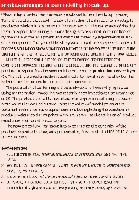
Sidebar: Previous attempts to use moldelling in scale up.
A simple and effective methodology for recipe-scale-up and process transfer that takes into account the variation of product resistance during the main drying, as well as the possibility that product resistance may change between freeze-dryers, is now available, and is described in detail in the literature (1, 2). Such an approach involves using mathematical modelling to simulate product evolution for a selected recipe, as well as a few experiments to determine model parameters and to characterise different freeze-dryers. The effect of parameter uncertainty can be easily accounted for, as can batch non-uniformity. Differences in the cake resistance, a consequence of differences in ice nucleation, can also be easily accounted for, but it will be necessary to characterise the cake obtained in industrial equipment.
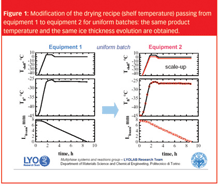
Figure 1: Modification of the drying recipe (shelf temperature) passing from equipment 1 to equipment 2 for uniform batches: the same product temperature (TB) and the same ice thickness evolution are obtained.
Figure 1 shows an example application of the proposed procedure. The red line is the new recipe that takes into account the higher heat transfer coefficient obtained in the industrial scale apparatus.
Characterising lyopilisation systems
The usual tools to characterise lyophilisation formulations are differential scanning calorimeter analysis and the cryomicroscope, which provide the collapse temperature and the temperature of occurring transformations.
If we consider the lyophilisation system (the freeze-dryer and the vials containing the product), then the two parameters that fully characterise the system are the effective heat transfer coefficient between the shelf and vial bottom (Kv) and the resistance to vapour flow of the dried cake (Rp) The knowledge of these quantities enables us to use modelling tools for scale up, obtaining the design space and off-line optimisation. These two parameters are required by any predictive control algorithm and, for this purpose, are generally estimated by the monitoring system. In practice, the dependence of the heat transfer coefficient on the chamber pressure is desired, which necessitates a series of experiments (at least three, at different pressures) to be conducted. With regards to resistance to vapour flow, the dependence on cake thickness must be evaluated. Only in relatively rare cases is this dependence linear; usually, asymptotic behaviour is observed. For products where microcollapse can occur, and in particular with sugars at a low solid concentration, it may be necessary to evaluate cake resistance at different temperatures. Of course, the other variable that is important to monitor is the sublimation rate.
Methods using the pressure rise test are useful because they enable the Kvv and Rp values to be determined in just one test, which only lasts a few seconds and does not require preliminary experiments. Different algorithms can be used [e.g., MTM (Manometric Temperature Measurent), DPE (Dynamic Parameters Estimation method), PRA (Pressure Raise Analysis)]: estimation is fast and can be conducted in-line. For control purposes, the accuracy is sufficient, although not perfect. The DPE+ algorithm directly measures the sublimation flux and provides a more robust estimation of the other parameters.
Another method that has been recently proposed is based on Tunable Diode Laser Absorption Spectroscopy (TDLAS). This technology uses Doppler-shifted near-infrared absorption spectroscopy to measure water vapour concentration and gas flow velocity in the duct connecting the freeze-drying chamber and condenser. The vapour mass flux can be calculated given an estimation of the velocity profile in the duct. This technique is interesting for measuring in-line sublimation flow and can speed up the experimental measuring campaign, even though its reliability is related to the correct estimation of the vapour velocity profile, which is not fully developed in practical conditions and is strongly dependent on the chamber conditions. Calculation of the parameters Kv and Rp is possible, but requires knowing the value of shelf temperature and of product temperature at the bottom and interface of sublimation, thus requiring additional experimental work to be applicable.
All these methods supply a batch average of the parameters. The only way to obtain the distribution of the variables of interest, and in particular the distribution of Kv, is by gravimetric methods. However, this is very time consuming as it requires a drying cycle to be conducted and then stopped during primary drying. A large number of vials must then be weighed to evaluate the sublimation rate of each vial.
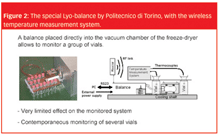
Figure 2: The special Lyo-balance by Politecnico di Torino, with the wireless temperature measurement system.Regarding cake resistance, this is related to the specific surface measured by BET adsorption techniques using inert gases (Argon), but it is not possible to estimate it based on this measurement. Similarly, it can be related to the average pore size, but cannot be estimated reliably from image analysis of the cake.
What is interesting, however, is the use of a special weighing device to estimate the value of Rp. Figure 2 shows such a device, equipped with a wireless temperature sensor to measure, without bias, the temperature in the weighed vials, realised by Politecnico di Torino (Italy). The device allows the Rp curve to be determined in a single run for industrial apparatus.
A detailed analysis of the different monitoring systems available for industrial processes, and of those proposed for laboratory use can be found in the literature (12–16).
Predictive modelling
Predictive modelling (Figure 3) can strongly improve lyophilisation processes in several ways. My research team has recently published several papers demonstrating that predictive modelling is not only possible, but reliable and effective, and has developed dedicated software for major multinational companies to solve specific requests.
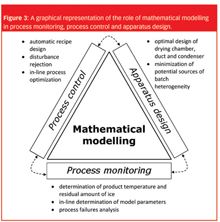
Figure 3: A graphical representation of the role of mathematical modelling in process monitoring, process control and apparatus design.
The first point to evidence is that modelling can be very useful, but only if the proper model is selected and developed, taking into account the allowed complexity and parameters that must be determined. Literature is rich of very detailed and accurate models, but a detailed model is not always a good model. The level of detail must be chosen according to the final use; for example, a model for predictive control will be different from a model for off-line optimisation. It must be stressed that the quality of the prediction generally depends more on the uncertainty connected with the parameters used, than on the complexity (and the dimension) of the model. The good engineering rule is that the model must be the simplest one that gives the requested accuracy.
A review of the different modelling approaches is available (17).
The second point is that modelling should supply the requested answer, and not just a lot of (perhaps interesting) data. To explain this concept, I will take the example of scale up. Recently a few papers were published that showed the use of modelling to address the scale up problem. In these cases, the model was used to supply predictions that helped to obtain the final recipe, but a lot of simulation work was required (together with experimental trials) because no direct answer was obtained. The straightforward approach, in my opinion, is to solve the "inverse problem": calculate the sequence of set points that enable you to obtain the required temperature history of the product.
The subject is very wide, so I will limit myself to evidence from the field where predictive modelling has already been used with success, in particular for the development of sensors, for equipment design and optimisation, and for in-line and off-line process optimisation. In some cases, commercial products are already available or will become available soon (18).
Sensor development
Predictive modelling can be used to develop software sensors. These sensors combine a model with physical measurements to estimate variables that cannot be measured directly. This is particularly interesting in freeze-drying because the main quantities of interest (residual amount of ice, residual moisture in secondary drying) cannot be measured directly. One example of this technology is "smart vials" where a temperature measurement of the product, or even of the vial wall, can be transformed into an estimation of interface temperature, residual ice or heat transfer coefficient. Another monitoring software, that takes advantage of the measurement of the water desorption rate, enables the residual moisture in secondary drying to be estimated, without the need to extract any sample, and to carry out preliminary experiments.
Tools for parameter identification are also available; an example are the methods based on the pressure rise test (this is carried out closing the duct from the chamber to the condenser for a few seconds), where the use of improved methods based on process modelling extends the range of operation and improves accuracy, especially for evaluating the parameters necessary for process control and optimisation (19–22).
Equipment design and optimisation
Equipment design can affect product quality and batch heterogeneity during operation (mainly during primary drying), through radiation, as well as through pressure gradients in the drying chamber and temperature gradients over the various shelves. The use of Computational Fluid Dynamics can be very effective, especially if dual-scale modelling approaches are adopted. When applied to the drying chamber, this approach can enable the variance of the batch to be estimated, and thus suggest the necessary modification of the design to reduce variance below a set value, or to estimate the influence of loading (and also of the clearance between shelves) to pressure drops. This allows also to evaluate whether the product uniformity is affected. Modelling can be used not only to improve the design of the drying chamber, but also that of the condenser and the selection of duct size and valves, which ensure the required performances. It is also possible to predict chocked flow conditions and, thus, the conductance of the apparatus (23).
Process optimisation and control
Model-based tools enable the freeze-drying of a pharmaceutical formulation in a specific freeze-dryer to be optimised, thus minimising the duration of the process, as well as maintaining product temperature below a limit value to preserve product quality. This can be done either off-line, using the design space concept, or in-line, using a predictive control algorithm.
In fact, if a preliminary investigation determines model parameters (cake resistance and an effective heat transfer coefficient), it is possible to optimise the recipe off-line using a mathematical model of the process to build the design space of the formulation. With this approach, it is also possible to build a design space for each group of vials, to take into account batch heterogeneity, thus identifying the optimal operating conditions for the whole batch. Modification of the cake resistance during drying can also be taken into account. The procedure is explained in detail in the references (24–25) and has been tested in industrial cases. Figure 4 shows an example for a placebo formulation.
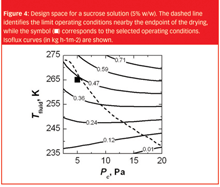
Figure 4: Design space for a sucrose solution (5% w/w). The dashed line identifies the limit operating conditions nearby the endpoint of the drying, while the square symbol corresponds to the selected operating conditions. Isoflux curves (in kg h-1m-2) are shown.
Using predictive control systems based on a simplified model can enable the development of an optimal freeze-drying cycle in a single run (12). For this purpose, it is necessary for sensors, such as those mentioned above, to supply both the status of the system and the value of the parameters of interest. A system of this type, which we have called LyoDriver (Figure 5) at the Politecnico di Torino, has been already developed and tested. The commercially available version makes use of the pressure rise test to monitor the process and, in particular, the DPE (26). A more sophisticated version takes advantages of the multivariate control approach (MPC) (27). Obviously, control algorithms can be used not only to develop optimal recipes, but eventually to automatically modify the recipe in a different piece of equipment. They can also control the process, rejecting disturbances and responding to undesired modification of the set point, thus avoiding product failure (28).
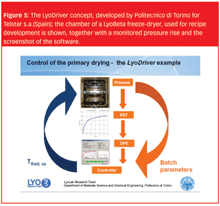
Figure 5: The LyoDriver concept, developed by Politecnico di Torino for Telstar s.a.(Spain); the chamber of a LyoBeta freeze-dryer, used for recipe development is shown, together with a monitored pressure rise and the screenshot of the software.
Finally, process transfer or scale-up can be made easier and more robust either using specific software after a process identification step or a software tool that can estimate in real time the consequences of process off-sets.
Controlling variance
The vials in the chamber of the freeze-dryer can exhibit different dynamics, resulting in intra-shelf variance and inter-shelves variance, which generally may be even larger. The causes, however, may differ. Even in a freeze-dryer that guarantees uniform operating conditions, the cake structure can be different because ice nucleation phenomenon is a stochastic event that may result in ice crystals of differing size, in a different resistance to mass transfer, and finally in a different drying kinetics and temperature profile. This phenomenon can be very pronounced in some limit cases, with freezing occurring over a long time interval and, thus, with very different supercooling for the different vials, which can be reduced only by utilising a device that controls nucleation.
Other causes of variance are radiation from the wall of the chamber, temperature gradients on the heating shelf, vapour fluid dynamics and non-uniform inert distribution (29).
Many factors contribute to significantly different heat transfer rates in the vials of a batch, such as the shape of the bottom of the vial, which affects the heat transfer from the fluid in the shelves to the product, the contact between the vials, and the radiation from the chamber walls and the chamber door. These effects can be minimised, improving the equipment design and reducing tolerance in vial manufacture.
Another significant cause of inter-vial variance is the fluid dynamics of the sublimating vapour inside the lyophilisation chamber. This effect can be efficiently investigated by using computational fluid dynamics, which evidences the influence of some geometrical parameters of the drying chamber (clearance between the shelves and position of the duct between the chamber and the condenser). The pressure gradients inside the chamber are important because the product temperature depends on the pressure (i.e., the higher the vapour pressure, the higher the product temperature) and, thus, represent a source of batch unevenness. Of course, irregular positioning of the stoppers can also be a cause of variance, affecting the total resistance to vapour flow and the product temperature.
Estimating variance is necessary to select a proper safety factor for the shelf temperature set point in order to avoid collapse or scorch in some vials that experience higher temperatures—to avoid collapse in vials that have a higher residual moisture content due to slower drying (or melting in case of residual ice), as a consequence of earlier transition to secondary drying step. The apparently strange phenomenon for which, in some productions, collapsed products are observed in vials in different position in the batch, without an apparent reason, can be simply attributed to the casual combination of different effects (cake resistance, gap at the vial bottom, temperature gradients on the shelf) in case the recipe has very low safety margins.
Different sublimation rates over the shelf can be easily measured by stopping a freeze-drying cycle and weighing a sufficient number of vials; an example of this type of experimental results is shown in the Figure 6. From these results, it is then possible to evaluate, for example, the distribution of the heat transfer coefficients and its average value and variance.
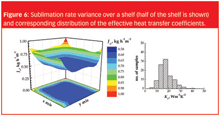
Figure 6: Sublimation rate variance over a shelf (half of the shelf is shown) and corresponding distribution of the effective heat transfer coefficients.
It is also possible to predict the behaviour of single vials in a batch, evaluating the effect of hydrodynamics, radiation and shelf temperature gradients. A dual-scale model is required for this purpose because it couples a 3D-model, describing the fluid dynamics in the chamber, and a second mathematical model, either mono- or bi-dimensional, describing the drying of the product in the vials. Different mathematical approaches are possible, as described in detail (18, 23). Figure 7 shows a conceptual scheme, with the two-way coupling of a CFD model and a one-dimensional model of the vial, which enables the evolution of the temperature variance of the product to be predicted over two different shelves: on the left a uniform batch obtained on a bottom shelf, on the right the variance over the shelf close to the duct, where strong pressure gradients were observed. The use of such a modelling tool can predict the expected variance with selected operating conditions, including the number of shelves, as well as the clearance between vial and upper shelf, and the stochastic variability of the cake resistance.
The variance of the batch, however, cannot be easily measured during the process, especially in industrial apparatus, but it is possible, using the soft-sensor described earlier to estimate the variables of interest in several vials placed in different position over the shelf.
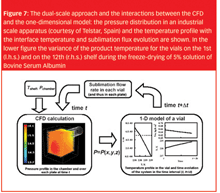
Figure 7: The dual-scale approach and the interactions between the CFD and the one-dimensional model: the pressure distribution in an industrial scale apparatus (courtesy of Telstar, Spain) and the temperature profile with the interface temperature and sublimation flux evolution are shown. In the lower figure the variance of the product temperature for the vials on the 1st (l.h.s.) and on the 12th (r.h.s.) shelf during the freeze-drying of 5% solution of Bovine Serum Albumin.
Even if is not an easy task, it is possible to improve the control system to manage heterogeneous batch. Two strategies can be followed.
The first involves monitoring in-line not only the average state of the batch, but also that of the edge vials characterised by a higher product temperature, and choosing the best heating strategy according to their state. A hybrid system can be realised: the DPE algorithm can be coupled with a system that estimates the variance of the batch using sensors that monitor the single vials, and the control system can calculate the control actions on the basis of the mean product temperature and of the temperature of the radiated vials.
A different strategy is to track the dynamics of vials placed in different positions of the batch by using the model previously validated, and thus to estimate the batch variance for certain operating conditions. This information can then be used to set the tuning parameters of the controller in such a way that it chooses the best control strategy to meet the product specifications of all the vials.
References
1. Fissore D., Pisano R. and Barresi A.A., 2010, A rational approach to process transfer and scale up in freeze-drying of pharmaceutical products. Drying 2010 - Proceedings of 17th International Drying Symposium (IDS2010) (E. Tsotsas, T. Metzger, M. Peglow, Eds.), October 3-6, Magdeburg, Germany, Vol. C, pp. 2178-2185. [ISBN: 978-3-86912-036-2]
2. Fissore D., Barresi A.A., 2011, Scale-up and process transfer of freeze-drying recipes. Drying Technol., in press.
3. Jennings T.A., 2002, Transferring the lyophilization process from one freeze-dryer to another. American Pharmaceutical Review 5, 34-42.
4. Rambhatla S.; Pikal M.J., 2003, Heat and mass transfer scale-up issues during freeze drying: I. Atypical radiation and the edge vial effect. AAPS PharmSciTech, 4, Article 14.
5. Rambhatla S., Ramot R., Bhugra C., Pikal M.J., 2004, Heat and mass transfer scale-up issues during freeze drying: II. Control and characterization of the degree of supercooling. AAPS PharmSciTech, 5, Article 58.
6. Rambhatla S., Tchessalov S., Pikal, M.J., 2006, Heat and mass transfer scale-up issues during freeze drying: III. Control and characterization of dryer differences via operational qualification tests. AAPS PharmSciTech, 7, Article 39.
7. Sane S.V., Hsu C.C., 2007, Strategies for successful lyophilization process scale-up. American Pharmaceutical Review, 10, 132-136.
8. Mungikar A., Ludzinski M., Kamat M., 2009, Evaluating functional equivalency as a lyophilization cycle transfer tool. Pharmaceutical Technology, 33, 54-70.
9. Jo, E., 2010, Guaranteeing a quality scale-up. Pharmaceuticals Manufacturing Packing Sourcer, 49, 62-28.
10. Konstantinidis A.K., Kuu W., Otten L., Nail S.L., Sever R.R., 2011, Controlled nucleation in freeze-drying: Effects on pore size in the dried product layer, mass transfer resistance, and primary drying rate, Journal of Pharmaceutical Sciences, 100, 3453–3470.
11. Passot S., Trelea I.C., Marin, M., Galan M., Morris G.J., Fonseca F., 2009, Effect of controlled ice nucleation on primary drying stage and protein recovery in vials cooled in a modified freeze-dryer. J Biomechanical Engineering, 131,1-5.
12. Fissore D., Barresi A.A., 2011, In-line product quality control of pharmaceuticals in freeze-drying processes, in “Modern Drying Technology Vol. 3: Product Quality and Formulation”, (E. Tsotsas and A.S. Mujumdar, Eds.), Chap. 4. Wiley-VCH Verlag GmbH + Co. KGaA, Weinhein, pp. 91-154. [ISBN 978-3527-31558-1].
13. Barresi A.A., Pisano R., Fissore D., Rasetto V, Velardi S.A., Vallan A., Parvis M., Galan M., 2009, Monitoring of the primary drying of a lyophilization process in vials. Chemical Engineering and Processing, 48 (1), 408-423. [DOI: 10.1016/j.cep.2008.05.004].
14. Fissore D., Pisano R., Rasetto V., Marchisio D.L., Barresi A.A., Vallan A., Corbellini S., 2009, Applying Process Analytical Technology (PAT) to the lyophilization process. Chimica Oggi/Chem. Today 27 (2, Supplement “Focus on Analytical technologies), VII-XI.
15. Fissore D., Pisano R., Barresi A.A., 2011, On the methods based on the Pressure Rise Test for monitoring a freeze-drying process. Drying Technology, 29 (1), 73-90. [DOI: 10.1080/07373937.2010.482715]
16. Barresi A.A., Fissore D., Pisano R., 2011, Heat transfer in freeze-drying apparatus, in ”Heat Transfer / Book 1 (M.A. dos Santos Bernardes, ed.)”, Intech [ISBN 978-953-307-317-0], in press.
17. Velardi S.A., Barresi A.A., 2008, Development of simplified models for the freeze-drying process and investigation of the optimal operating conditions. Chemical Engineering Research and Design, 86(1), 9-22. [DOI: 10.1016/j.cherd.2007.10.007]
18. Barresi A.A., Fissore D., Marchisio D., 2010, Process Analytical Technology in industrial freeze-drying, in: "Freeze-Drying/Lyophilization of Pharmaceuticals and Biological Products, 3rd rev. Edition" (L. Rey and J. C. May, Eds.), Chap. 20. Informa Healthcare, New York, pp. 463-496.
19. Barresi A.A., Velardi S.A., Pisano R., Rasetto V., Vallan A., Galan M., 2009, In-line control of the lyophilization process. A gentle PAT approach using software sensors. International Journal of Refrigeration, 32, 1003-1014. [DOI: 10.1016/j.ijrefrig.2008.10.012]
20. Velardi S.A., Rasetto V., Barresi A.A., 2008, Dynamic Parameters Estimation method: advanced Manometric Temperature Measurement approach for freeze-drying monitoring of pharmaceuticals solutions. Industrial Engineering Chemistry Research, 47(21), 8445-8457. [DOI:10.1021/ie7017433]
21. Fissore D., Pisano R., Barresi A.A., 2011, On the methods based on the Pressure Rise Test for monitoring a freeze-drying process. Drying Technology, 29 (1), 73-90. [DOI: 10.1080/07373937.2010.482715]
22. Fissore D., Pisano R., Barresi A.A., 2011, Monitoring of the secondary drying in freeze drying of pharmaceuticals. Journal of Pharmaceutical Science, 100 (2), 732-742. [DOI: 10.1002/jps22311]
23. Rasetto V., Marchisio D.L., Fissore D., Barresi A.A., 2010, On the use of a dual-scale model to improve understanding of a pharmaceutical freeze-drying process. Journal of Pharmaceutical Science, 99 (10), 4337-4350. [DOI: 10.1002/jps.22127]
24. Giordano A., Barresi A.A., Fissore D., 2011, On the use of mathematical models to build the design space for the primary drying phase of a pharmaceutical lyophilization process. Journal of Pharmaceutical Science ,100 (1), 311-324. [DOI: 10.1002/jps.22264]
25. Fissore D., Pisano R., Barresi A.A., 2011, Advanced approach to build the design space for the primary drying of a pharmaceutical freeze-drying process. Journal of Pharmaceutical Science, in press (available on-line) [DOI 10.1002/jps.22668]
26. Pisano R., Fissore D., Velardi S.A., Barresi A.A., 2010, In-line optimization and control of an industrial freeze-drying process for pharmaceuticals. Journal of Pharmaceutical Science, 99 (11), 4691-4709. [DOI: 10.1002/jps.22166]
27. Pisano R., Fissore D., Barresi A.A., 2010, On the use of a MPC algorithm for the in-line optimization of a pharmaceutical freeze-drying process. Drying 2010 - Proceedings of 17th International Drying Symposium (IDS2010) (E. Tsotsas, T. Metzger, M. Peglow, Eds.), October 3-6, Magdeburg, Germany, Vol. A, pp. 628-634. [ISBN: 978-3-86912-036-2]
28. Fissore D., Pisano R., Velardi S.A., Barresi A.A., Galan M., 2009, PAT Tools for the optimization of the freeze-drying process. Pharmaceutical Engineering, 29 (5), 58-70.
29. Barresi A.A., Pisano R., Rasetto V., Fissore D., Marchisio D.L., 2010, Model-based monitoring and control of industrial freeze-drying processes: effect of batch nonuniformity. Drying Technology, 28 (5), 577-590. [DOI: 10.1080/07373931003787934]
Pharmaceutical Tariffs Are Imminent: How Industry is Bracing for Impact
April 16th 2025On April 14, 2025, the Trump Administration launched a national security-driven investigation into pharmaceuticals, a move that will likely result in tariffs being placed on pharmaceutical drugs, ingredients, and other components that are imported from outside of the United States.
Drug Solutions Podcast: A Closer Look at mRNA in Oncology and Vaccines
April 30th 2024In this episode fo the Drug Solutions Podcast, etherna’s vice-president of Technology and Innovation, Stefaan De Koker, discusses the merits and challenges of using mRNA as the foundation for therapeutics in oncology as well as for vaccines.
